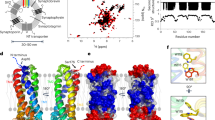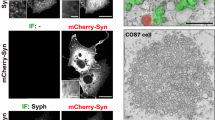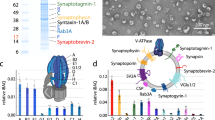Abstract
Here, to study lipid–protein interactions that contribute to the biogenesis of regulated secretory vesicles, we have developed new approaches by which to label proteins in vivo, using photoactivatable cholesterol and glycerophospholipids. We identify synaptophysin as a major specifically cholesterol-binding protein in PC12 cells and brain synaptic vesicles. Limited cholesterol depletion, which has little effect on total endocytic activity, blocks the biogenesis of synaptic-like microvesicles (SLMVs) from the plasma membrane. We propose that specific interactions between cholesterol and SLMV membrane proteins, such as synaptophysin, contribute to both the segregation of SLMV membrane constituents from plasma-membrane constituents, and the induction of synaptic-vesicle curvature.
This is a preview of subscription content, access via your institution
Access options
Subscribe to this journal
Receive 12 print issues and online access
$209.00 per year
only $17.42 per issue
Buy this article
- Purchase on SpringerLink
- Instant access to full article PDF
Prices may be subject to local taxes which are calculated during checkout








Similar content being viewed by others
References
Kirchhausen, T., Bonifacino, J. S. & Riezman, H. Linking cargo to vesicle formation: receptor tail interactions with coat proteins. Curr. Opin. Cell Biol. 9, 488–495 (1997).
Brown, D. & London, E. Functions of lipid rafts in biological membranes. Annu. Rev. Cell Dev. Biol. 14, 111–136 (1998).
Simons, K. & Ikonen, E. Functional rafts in cell membranes . Nature 387, 569–572 (1997).
Thiele, C. & Huttner, W. B. Protein and lipid sorting from the trans-Golgi network to secretory granules — recent developments . Semin. Cell Dev. Biol. 9, 511– 516 (1998).
Nickel, W., Bruegger, B. & Wieland, F. T. Protein and lipid sorting between the endoplasmatic reticulum and the Golgi complex. Semin. Cell Dev. Biol. 9, 493–502 (1998).
Brown, D. A. & Rose, J. K. Sorting of GPI-anchored proteins to glycolipid-enriched membrane subdomains during transport to the apical cell surface. Cell 68, 533– 544 (1992).
Radhakrishnan, R. et al. Phospholipids containing photoactivable groups in studies of biological membranes. Ann. NY Acad. Sci. 346, 165–198 (1980).
Stoffel, W., Salm, K.-P. & Mueller, M. Syntheses of phosphatidylcholines, sphingomyelins and cholesterol substituted with azido fatty acids. Hoppe-Seylers Z. Physiol. Chem. 363, 1–18 (1982).
Stoffel, W. & Metz, P. Covalent cross-linking of photosensitive phospholipids to human serum high density apolipoproteins (apoHDL). Hoppe-Seylers Z. Biol. Chem. 360, 197– 206 (1979).
Westerman, J. et al. Identification of the lipid binding site of phosphatidylcholine-transfer protein with phosphatidylcholine analogs containing photoactivable carbene precursors. Eur. J. Biochem. 132, 441– 449 (1983).
Pryde, J. G. & Phillips, J. H. Fractionation of membrane proteins by temperature-induced phase separation in Triton X-114. Biochem. J. 233, 525–533 ( 1986).
Kurzchalia, T. V. et al. VIP21, a 21-kD membrane protein is an integral component of trans-Golgi-network-derived transport vesicles. J. Cell Biol. 118, 1003–1014 (1992).
Murata, M. et al. VIP21/caveolin is a cholesterol-binding protein. Proc. Natl Acad. Sci. USA 92, 10339– 10343 (1995).
Ikonen, E. Molecular mechanisms of intracellular cholesterol transport. Curr. Opin. Lipidol. 8, 60–64 (1997).
Iwata, S., Ostermeier, C., Ludwig, B. & Michel, H. Structure at 2.8 Å resolution of cytochrome c oxidase from Paracoccus denitrificans. Nature 376, 660– 669 (1995).
Tooze, S. A. & Huttner, W. B. Cell-free protein sorting to the regulated and constitutive secretory pathways. Cell 60, 837–847 (1990).
Clift-O’Grady, L., Linstedt, A. D., Lowe, A. W., Grote, E. & Kelly, R. B. Biogenesis of synaptic vesicle-like structures in a pheochromocytoma cell line. J. Cell Biol. 110, 1693–1703 (1990).
Corradi, N. et al. Overall lack of regulated secretion in a PC12 variant cell clone. J. Biol. Chem. 271, 27116– 27124 (1996).
Finbow, M. E. & Harrison, M. A. The vacuolar H-ATPase: a universal proton pump. Biochem. J. 324, 697– 712 (1997).
Jahn, R. & Südhof, T. C. Synaptic vesicles and exocytosis . Annu. Rev. Neurosci. 17, 219– 246 (1994).
Bauerfeind, R., Jelinek, R. & Huttner, W. B. Synaptotagmin I- and II-deficient PC12 cells exhibit calcium-independent, depolarization-induced neurotransmitter release from synaptic-like microvesicles. FEBS Lett. 364, 328–334 (1995).
Schmidt, A., Hannah, M. J. & Huttner, W. B. Synaptic-like microvesicles of neuroendocrine cells originate from a novel compartment that is continuous with the plasma membrane and devoid of transferrin receptor. J. Cell Biol. 137 , 445–458 (1997).
Lichtenstein, Y., Desnos, C., Fàundez, V., Kelly, R. B. & Clift-O’Grady, C. Vesiculation and sorting from PC12-derived endosomes in vitro. Proc. Natl Acad. Sci. USA 95, 11223–11228 ( 1998).
Schmidt, A. & Huttner, W. B. Biogenesis of synaptic-like microvesicles in perforated PC12 cells. Methods: Companion to Methods Enzymol. 16, 160–169 ( 1998).
Trowbridge, I. S., Collawn, J. F. & Hopkins, C. R. Signal-dependent membrane protein trafficking in the endocytic pathway. Annu. Rev. Cell Biol. 9, 129–161 (1993).
Evans, W. H. & Hardison, W. G. Phospholipid, cholesterol, polypeptide and glycoprotein composition of hepatic endosome subfractions. Biochem. J. 232, 33–36 ( 1985).
Breckenridge, W. C., Morgan, I. G., Zanetta, J. P. & Vincendon, G. Adult rat brain synaptic vesicles. II. Lipid composition. Biochim. Biophys. Acta 320, 681–686 (1973).
Perez-Castineira, J. R. & Apps, D. K. Vacuolar H(+)-ATPase of adrenal secretory granules. Rapid partial purification and reconstitution into proteoliposomes. Biochem. J. 271, 127 –131 (1990).
Thomas, L. et al. Identification of synaptophysin as a hexameric channel protein of the synaptic vesicle membrane. Science 242, 1050–1053 (1988).
Monier, S. et al. VIP21-caveolin, a membrane protein constituent of the caveolar coat, oligomerizes in vivo and in vitro. Mol. Biol. Cell 6, 911–927 (1995).
Rodal, S. K. et al. Extraction of cholesterol with methyl-beta-cyclodextrin perturbs formation of clathrin-coated endocytic vesicles. Mol. Biol. Cell 10, 961–974 ( 1999).
Subtil, A. et al. Acute cholesterol depletion inhibits clathrin-coated pit budding . Proc. Natl Acad. Sci. USA 96, 6775– 6780 (1999).
Keller, P. & Simons, K. Cholesterol is required for surface transport of influenza virus hemagglutinin. J. Cell Biol. 140, 1357–1367 (1998).
Ledesma, M. D., Simons, K. & Dotti, C. G. Neuronal polarity: essential role of protein-lipid complexes in axonal sorting. Proc. Natl Acad. Sci. USA 95, 3966–3971 (1998).
Hannah, M. J., Weiss, U. & Huttner, W. B. Differential extraction of proteins from paraformaldehyde-fixed cells: lessons from synaptophysin and other membrane proteins. Methods: Companion to Methods Enzymol. 16, 170– 181 (1998).
Brand, S. H. & Castle, J. D. SCAMP 37, a new marker within the general cell surface recycling system. EMBO J. 12, 3753–3761 (1993).
Wu, T. T. & Castle, J. D. Evidence for colocalization and interaction between 37 and 39 kDa isoforms of secretory carrier membrane proteins (SCAMPs). J. Cell Sci. 110, 1533– 1541 (1997).
Molday, R. S., Hicks, D. & Molday, L. Peripherin. A rim-specific membrane protein of rod outer segment discs. Invest. Ophthalmol. Vis. Sci. 28, 50–61 (1987).
Goldberg, A. F. & Molday, R. S. Subunit composition of the peripherin/rds-rom-1 disk rim complex from rod photoreceptors: hydrodynamic evidence for a tetrameric quaternary structure. Biochemistry 35, 6144–6149 (1996).
Church, R. F. R. & Weiss, M. J. Diazirines. II. Synthesis and properties of small functionalized diazirine molecules. Some observations on the reaction of a diaziridine with the iodine-iodide ion system . J. Org. Chem. 35, 2465– 2471 (1970).
Spector, A. A. & Hoak, J. C. An improved method for the addition of long-chain free fatty acid to protein solutions. Anal. Biochem. 32, 297–302 (1969).
Beisswanger, R. et al. Existence of distinct tyrosylprotein sulfotransferase genes: molecular characterization of tyrosylprotein sulfotransferase-2. Proc. Natl Acad. Sci. USA 95, 11134– 11139 (1998).
Huttner, W. B., Schiebler, W., Greengard, P. & De Camilli, P. Synapsin I (protein I), a nerve terminal-specific phosphoprotein. III. Its association with synaptic vesicles studied in a highly purified synaptic vesicle preparation. J. Cell Biol. 96, 1374– 1388 (1983).
Baumert, M., Maycox, P.R., Navone, F., De Camilli, P. & Jahn, R. Synaptobrevin: an integral membrane protein of 18,000 daltons present in small synaptic vesicles of rat brain. EMBO J. 8, 379–384 ( 1989).
Heumann, R., Kachel, V. & Thoenen, H. Relationship between NGF-mediated volume increase and “priming effect” in fast and slow reacting clones of PC12 pheochromocytoma cells. Exp. Cell Res. 145, 179– 190 (1983).
Pimplikar, S., Ikonen, E. & Simons, K. Basolateral protein transport in streptolysin O-permeabilized MDCK cells. J. Cell Biol. 125, 1025– 1035 (1994).
Zacchetti, D., Peränen, J., Murata, M., Fiedler, K. & Simons, K. VIP17-MAL, a proteolipid in apical transport vesicles. FEBS Lett. 377, 465– 469 (1995).
Klein, U., Gimpl, G. & Fahrenholz, F. Alteration of the myometrial plasma membrane cholesterol content with beta cyclodextrin modulates the binding affinity of the oxytocin receptor. Biochemistry 34, 13784– 13793 (1995).
Acknowledgements
We thank A. Bosserhoff and R. Frank for mass spectrometry of V-ATPase c; K. Burger for help with photocholesterol synthesis; R. Sandhoff and F. Wieland for mass spectrometry of photocholesterol; A. Schmidt for advice on analysis of PC12 cell SLMVs; and P. Rosa and J. Meldolesi for PC12 clone 27 cells. This work was supported by grants from the DFG (SFB 317, C2 to W.B.H.; SFB 474 to F.F.), the EC (ERB-FMRX-CT96-0023 and ERBBIO4CT960058 to W.B.H.) and the FCI (to W.B.H.).
Correspondence and requests for materials should be addressed to C.T. or W.B.H.
Supplementary information is available on Nature Cell Biology’s World-Wide Web site (http://cellbio.nature.com) or as paper copy from the London editorial office of Nature Cell Biology.
Author information
Authors and Affiliations
Corresponding authors
Supplementary information
Rights and permissions
About this article
Cite this article
Thiele, C., Hannah, M., Fahrenholz, F. et al. Cholesterol binds to synaptophysin and is required for biogenesis of synaptic vesicles. Nat Cell Biol 2, 42–49 (2000). https://doi.org/10.1038/71366
Received:
Revised:
Accepted:
Published:
Issue Date:
DOI: https://doi.org/10.1038/71366
This article is cited by
-
APOB100 transgenic mice exemplify how the systemic circulation content may affect the retina without altering retinal cholesterol input
Cellular and Molecular Life Sciences (2024)
-
Regulation of membrane protein structure and function by their lipid nano-environment
Nature Reviews Molecular Cell Biology (2023)
-
The translational potential of cholesterol-based therapies for neurological disease
Nature Reviews Neurology (2023)
-
The normalizing effects of the CYP46A1 activator efavirenz on retinal sterol levels and risk factors for glaucoma in Apoj−/− mice
Cellular and Molecular Life Sciences (2023)
-
Molecular landscape of BoNT/B bound to a membrane-inserted synaptotagmin/ganglioside complex
Cellular and Molecular Life Sciences (2022)



